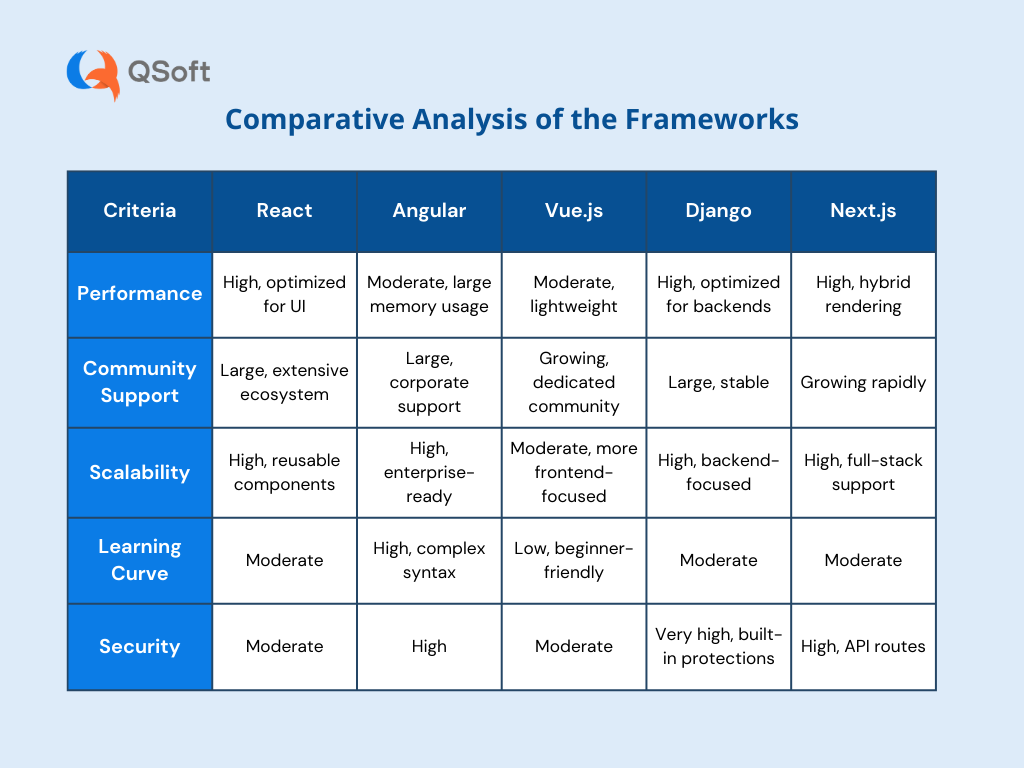Top 5 Best Web Frameworks in 2024
In an era where web applications are at the heart of businesses across industries, selecting the right and best web app framework can determine the success and scalability of a project. Web frameworks streamline the complexities of development, providing essential tools, pre-built components, and structured workflows to create high-performance applications. With a multitude of choices available, 2024 has seen some frameworks standing out due to their adaptability, community support, and unique feature sets.
In this comprehensive guide, we’ll cover the best frameworks for web development that 2024 has to offer, focusing on their strengths, recent developments, and how they can serve various project needs. This blog will also guide you in selecting the framework that best suits your project requirements.
1. Introduction to Web Frameworks and Their Importance
Web frameworks are foundational tools in modern web development, offering a structured environment to streamline the creation of web applications. By providing pre-built components and libraries, frameworks allow developers to focus on unique features rather than common functionalities, which speeds up development and ensures consistency.
Why Web Frameworks Matter in 2024
In 2024, the expectations for web applications are higher than ever, with users demanding fast, scalable, and secure experiences. Web frameworks have become essential for meeting these standards:
- Accelerated Development: Frameworks come with ready-made tools and libraries, which reduce coding time and help developers launch projects faster.
- Code Consistency and Collaboration: A structured approach keeps code organized and maintainable, essential for larger teams working on complex applications.
- Scalability: With built-in support for modular architecture, frameworks enable applications to grow alongside the business with minimal rework.
- Security: Many frameworks include protections against common vulnerabilities, providing a safer foundation for applications handling sensitive data.
2. Criteria for Selection
Choosing the right web framework requires a careful look at key criteria to ensure it aligns with your project’s goals. Here are five primary factors to consider:
- Performance and Speed: When considering the best web development framework, evaluating performance and speed is crucial, as users increasingly expect high-performance web frameworks that support complex interactions. A fast, responsive framework improves user experience and supports complex interactions. Frameworks like React, with its Virtual DOM, and Next.js, with server-side rendering (SSR), excel at handling high-performance demands.
- Community Support and Resources: An active community provides valuable resources, from plugins to troubleshooting help. Frameworks like Angular and React benefit from large communities, ensuring continued innovation and abundant support.
- Scalability: For growing applications, scalability is crucial. Frameworks such as Angular and Django offer modular architectures that allow applications to expand without major rework, making them ideal for long-term projects.
- Security Features: Built-in security is essential to protect against vulnerabilities. Frameworks like Django for backend development include critical security features that protect against vulnerabilities, ideal for applications requiring a secure foundation
- Ease of Use and Learning Curve: Frameworks with an accessible learning curve, like Vue.js, speed up onboarding and productivity, while more complex frameworks like Angular offer robust tools but may require additional training.
3. Overview of Each Framework
Let’s delve into the unique strengths of each of the top frameworks for web development in 2024.
Framework 1: React (Frontend)
- Overview: React, developed and maintained by Facebook, is a JavaScript library popular for building user interfaces, particularly single-page applications (SPAs). Its component-based structure allows developers to create reusable UI components, which is ideal for large-scale applications.
- Key Features:
- Virtual DOM: React uses a virtual DOM to optimize updates, allowing for high performance and responsiveness.
- Component-Based Architecture: Components in React are reusable, which speeds up development and reduces code redundancy.
- React Native Compatibility: React’s compatibility with React Native makes it easier to transition web applications to mobile applications.
- Extensive Ecosystem: The large community around React has created numerous tools and libraries, such as Redux for state management and React Router for navigation.
- Why It’s Popular in 2024: In 2024, React remains dominant due to its flexibility and efficiency in handling dynamic UIs. Its recent updates focus on concurrent features, server-side rendering, and performance optimizations that make it highly suitable for real-time applications.
- Best Use Cases: Ideal for interactive UIs, SPAs, large-scale applications, and applications that may expand to mobile interfaces.
Framework 2: Angular (Frontend)
- Overview: Angular is a comprehensive web framework for enterprise applications developed by Google for building dynamic web apps. Unlike React, which is primarily a library, Angular offers a complete toolkit, including dependency injection, forms, HTTP requests, and routing.
- Key Features:
- Two-Way Data Binding: Angular’s two-way binding feature automatically synchronizes data between the model and the view, which streamlines code and reduces errors.
- Dependency Injection: Angular uses dependency injection, making the code more modular, maintainable, and testable.
- Angular CLI: The Angular CLI (Command Line Interface) simplifies the development process, providing commands for adding new components, testing, and more.
- Modularity: Angular allows for a highly modular structure, where every part of the app can be developed independently and integrated later.
- Why It’s Popular in 2024: With the latest version, Angular focuses on improving performance with the Ivy rendering engine, which optimizes bundle size and load speed. Google’s continued support has made Angular a reliable choice for enterprise applications, where stability, scalability, and long-term maintenance are crucial.
- Best Use Cases: Best suited for large-scale applications, enterprise-grade applications, and projects requiring high maintainability and long-term support.
Framework 3: Vue.js (Frontend)
- Overview: Vue.js, created by Evan You, is a progressive JavaScript framework for building UIs and SPAs. Vue.js, a lightweight web development framework, is easy to learn and adaptable, making it an excellent choice for rapid development and SEO-friendly applications.
- Key Features:
- Reactive Data Binding: Vue’s reactivity system ensures seamless updates between data and UI.
- Flexibility and Modularity: Vue can function as a library for a single page or scale to manage a large, complex application.
- Single-File Components: Vue enables developers to encapsulate HTML, JavaScript, and CSS in a single file, making code organization simpler.
- Vue CLI: Vue CLI provides a pre-configured project setup and allows easy customization.
- Why It’s Popular in 2024: Vue has gained traction as a lightweight, flexible alternative to larger frameworks like Angular and React. Its 2024 updates focus on better TypeScript support and performance enhancements, which have increased its appeal in more complex applications.
- Best Use Cases: Excellent for lightweight applications, prototyping, and projects where time-to-market is essential.
Framework 4: Django (Backend)
- Overview: Django is a high-level Python framework that promotes rapid development and clean, pragmatic design. Known for its “batteries-included” philosophy, Django comes with built-in features such as an ORM, authentication, and admin panels.
- Key Features:
- Comprehensive ORM: Django’s Object-Relational Mapping (ORM) feature allows developers to interact with databases without extensive SQL knowledge.
- Built-In Admin Interface: Django’s admin interface is auto-generated, saving time on developing admin dashboards.
- Security: Django offers strong security features, including CSRF, SQL injection protection, and user authentication.
- Asynchronous Capabilities: The latest versions of Django support asynchronous views, making it suitable for handling a large number of concurrent users.
- Why It’s Popular in 2024: In 2024, Django remains one of the top frameworks for backend development due to its robust security, extensive documentation, and rapid development capabilities. Django’s community has made it a stable and reliable option, particularly for applications that handle sensitive information.
- Best Use Cases: Ideal for full-stack applications, secure apps handling sensitive data, content management systems, and eCommerce platforms.
Framework 5: Next.js (Full-Stack)
- Overview: Next.js is a full-stack framework built on top of React, ideal for server-rendered applications. It combines the flexibility of React with server-side rendering (SSR) and static site generation (SSG), making it the best framework for SEO-friendly web development.
- Key Features:
- Server-Side Rendering (SSR): Next.js supports SSR, enabling better performance and SEO.
- API Routes: API routes allow developers to create a backend directly within Next.js without needing a separate backend server.
- Automatic Static Optimization: Next.js automatically optimizes static pages, which can load instantly and improve user experience.
- Built-In CSS and Image Optimization: Next.js provides optimized support for CSS and images, further enhancing load times and performance.
- Why It’s Popular in 2024: Next.js’s 2024 updates have improved performance through streaming features and API enhancements. Its ability to support both SSR and static generation makes it versatile and powerful for modern, performance-intensive web applications.
- Best Use Cases: Perfect for eCommerce websites, blogs, hybrid applications (static + dynamic), and projects that require both front and back-end support.
4. Comparative Analysis of the Frameworks
Here’s a comparative look at the major aspects of each framework:

5. Choosing the Right Framework for Your Needs
Choosing the right framework can make a significant difference in your project’s development speed, scalability, and future maintenance needs. Here’s a guide to help align each framework’s strengths with different project goals:
For Full-Stack or SEO-Driven Applications: If your project requires both front-end and back-end support with a strong focus on SEO, Next.js is a standout choice for SEO-friendly web development. Built on React, Next.js allows for server-side rendering (SSR) and static site generation (SSG), which improve SEO and page load speeds. This flexibility makes it ideal for dynamic, content-heavy applications like eCommerce websites, marketing sites, and blogs that benefit from optimized indexing. Additionally, Next.js supports hybrid applications where some pages are server-rendered for SEO while others are statically generated for performance.
For High-Performance UIs and Real-Time Interaction: React excels at building interactive, high-performance user interfaces. Its Virtual DOM allows React to selectively update parts of the UI, resulting in faster and more efficient rendering, which is ideal for single-page applications (SPAs) and applications that require real-time data updates, like social media platforms, interactive dashboards, or streaming services. With React’s component-based structure, developers can create reusable UI elements, speeding up development while maintaining a consistent user experience. It’s especially beneficial for teams focused on creating rich, dynamic front-end interfaces.
For Large-Scale, Enterprise-Level Applications: Angular is a comprehensive framework developed by Google, tailored for building robust, large-scale applications with complex structures. Its emphasis on architecture and its features like dependency injection, two-way data binding, and a powerful CLI make it well-suited for enterprise environments. Companies managing large teams and complex applications benefit from Angular’s strict conventions, which promote code consistency across teams. Its modularity and rich set of tools also ensure that projects are scalable and maintainable, making Angular an ideal choice for long-term, enterprise-grade applications like CRM systems, ERP solutions, and eCommerce platforms.
For Rapid Prototyping or Lightweight Applications: Vue.js is perfect for projects that require a quick development cycle, flexibility, and ease of integration. Vue’s gentle learning curve and versatile structure make it ideal for small to mid-sized applications, startups, and proof-of-concept projects where time-to-market is a priority. Its simplicity also allows teams to experiment and iterate quickly, making Vue a go-to for developers who need a framework that can be set up easily and start delivering results fast. Vue can also scale moderately well, so it’s ideal for projects that may grow over time but do not require the full complexity of an enterprise solution.
For Backend-Focused or Security-Sensitive Applications: Django, a high-level Python framework, is a top choice for backend-heavy projects, particularly those handling sensitive data, such as healthcare or finance. Django’s “batteries-included” approach means it comes with built-in tools for common web development needs, including authentication, ORM, and an admin interface, all of which reduce development time and increase security. Django is highly regarded for its robust security features that help protect against common vulnerabilities like SQL injection, cross-site scripting (XSS), and cross-site request forgery (CSRF). For data-driven applications with high security needs, Django for backend development provides an ideal solution with built-in protections and a robust backend-focused architecture.
Conclusion
Selecting the right web framework is crucial for building applications that are not only high-performing but also scalable, secure, and easy to maintain. In 2024, frameworks like React, Angular, Vue.js, Django, and Next.js lead the industry due to their unique capabilities and the value they bring to diverse project needs. Whether you’re developing a real-time interactive app, a secure data-driven backend, or an SEO-friendly platform, each framework offers distinct advantages.
By aligning your project goals with the strengths of each framework, you can make a well-informed decision that ensures your application’s long-term success. No matter your specific requirements—be it fast development, enterprise-level scalability, or enhanced security—choosing the best framework for web development sets a strong foundation for your project. Explore these frameworks, leverage their strengths, and position your application to meet the demands of today’s digital landscape.

